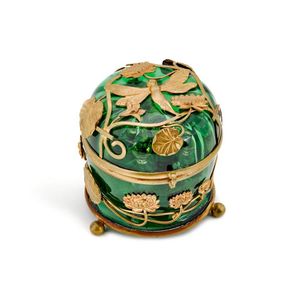Art Nouveau Loetz Gilt Metal Mounted Green Glass Compendium
You must be a subscriber, and be logged in to view price and dealer details.
Subscribe Now to view actual auction price for this item
When you subscribe, you have the option of setting the currency in which to display prices to $Au, $US, $NZ or Stg.
- Art Nouveau Period - The Art Nouveau period was a cultural movement that emerged in the late 19th century, and was characterized by its emphasis on natural forms, flowing lines, and a decorative, ornamental style. Art Nouveau was a reaction against the ornate and heavily stylized designs of the previous era, and sought to create a new, more organic aesthetic.
Art Nouveau was characterized by its use of sinuous, curving lines, as well as a focus on natural elements such as flowers, vines, and other organic shapes. Art Nouveau designers sought to create a total work of art, in which every element of a building or object was designed to be harmonious with the overall design.
Some of the most iconic examples of Art Nouveau design include the Paris Metro entrances designed by Hector Guimard, the works of the artist Alphonse Mucha, and the architecture of Victor Horta in Brussels.
The Art Nouveau period was at its peak between 1890 and 1910, but began to decline in popularity by the start of World War I. However, Art Nouveau remains an important influence on design and art to this day, and continues to be celebrated for its emphasis on natural forms and decorative style. - Foliate - Decorated with leaves or leaf-like forms.
This item has been included into following indexes:
Visually similar items

A Chinese famille verte porcelain garden stool, 19th century drum formed with pierced rondells and rockery scenes, 45 cm high

A Chinese enamelled and gilded cloisonne lidded box, the lovely round box, gilded at the edges, depicting a scrolling lotus design and open lotus flower heads, with a navy and gilded ruyi border to the box and cover, all over a turquoise ground, 6.5 cm hig

A Chinese Straits porcelain jar with yellow glaze, decorated in overglaze enamel of a birds in flowering branches, height 28 cm

A Chinese circular fahua type porcelain lidded box, with pierced decoration and raised floral designs in green, ochre and aubergine. Diameter 15 cm.
